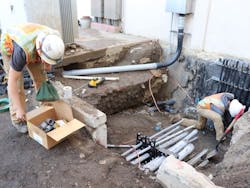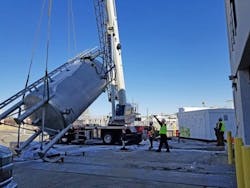About the author:
Cristina Tuser is associate editor for WWD. Tuser can be reached at [email protected].
Location: Longmont, Colorado
Size: 13 MGD
Equipment: Gravity thickeners, dissolved air flotation thickener, centrifuge dewatering system, equalization basin
In 2013, Longmont, Colorado, experienced a 100-year rain event that inundated much of the city in floodwaters. Hundreds of residents were displaced, while personal property, businesses and public spaces were destroyed. The flooding caused extensive damage to much of Longmont’s infrastructure and along the St. Vrain Greenway trail system.
As a result, city staff were faced with the pressure and responsibility of quickly adjusting plans to service critical needs. Many facilities at the Longmont Wastewater Treatment Plant (WWTP) were under water, so operators were forced to configure the plant that would preserve biological mass while treating wastewater.
Non-essential processes were shut down and critical task lists were developed. This included coordinating with local utility companies and creating quick services with on-call contractors, as well as re-establishing SCADA communications. Fortunately, this led to the WWTP meeting permit requirements just 48 hours after the flood event occurred.
“The city’s wastewater utility prides itself in its resilient organization, consistent results, and sustainable initiatives,” said John Gage, P.E., civil engineer II, for the city of Longmont Public Works & Natural Resources. “Consistent results are achieved through extensive documentation and thorough training protocols. The WWTP staff have developed over 250 standard operating procedures (SOPs) that are used to enhance safety, protect process integrity, and train new employees. These tools have led to over 10 years of consistent operation without a permit excursion.”
At the WWTP, the liquid treatment process consists of the following: influent screening, grit removal, equalization basin, primary clarification, activated sludge operating in a Modified Ludzack-Ettinger Process (MLE) configuration, secondary clarification and ultraviolet (UV) disinfection. The treated wastewater is discharged to the St. Vrain Creek. The solids treatment process consists of the following: gravity thickeners for thickening primary sludge; a dissolved air flotation thickener (DAFT) for thickening waste activated sludge; anaerobic digestion; and centrifuge dewatering. The digested and dewatered solids are hauled and applied to local farm lands.
The wastewater staff are organized between Operations, Maintenance, and Instrumentation & Controls (I&C). The staff in these three areas are cross-trained as wastewater operators. Due to the COVID-19 pandemic, these three cross-training groups allowed staff to break into smaller teams. The goal of this is to separate employees while maintaining essential services.
According to Gage, the city has pursued many sustainable initiatives, including large scale projects, such as a Renewable Natural Gas (RNG) project, and smaller efficiency upgrades, such as the replacement of lights with higher efficiency LEDs.
In 2020, the WWTP completed a RNG project. CGRS built the city of Longmont’s Biogas Treatment and RNG Fueling Station Project at the WWTP. This project aimed to transform sewage gas from the wastewater treatment process into sustainable fuel for the city’s garbage trucks. CGRS began working in late 2018 and finished the project in early 2020.
A gas treatment system was installed to treat biogas generated from anaerobic digestion up to natural gas quality, according to Gage.
“The system consists of processes that strip the biogas of corrosive H2S, capture siloxane particles to protect engines, draw out moisture to prevent corrosion, and selectively remove a large portion of CO2 to concentrate the methane content in the biogas,” Gage said about the project.
The RNG is then compressed and sent to a new time-fill Compressed Natural Gas (CNG) fueling station for the city’s Waste Services fleet. Previously, the city’s Waste Services fleet consisted of 19 diesel sanitation trucks and was the largest consumer of fuel among any city division. Since the execution of the project, Longmont has replaced 11 diesel Waste Services trucks with new CNG trucks that utilize the RNG produced at the WWTP.
The conversion of the Waste Services fleet is estimated to offset more than 100,000 gallons of fossil fuels annually. As a result of this success, the Waste Services division will continue to purchase CNG trucks. When it comes to future upgrades, the city is currently evaluating alternatives to meet more stringent nutrient limits. According to the city, its NPDES discharge permit was renewed in 2019 and includes a compliance schedule to meet new total phosphorus (TP) and total inorganic nitrogen (TIN) limits. This means the city will assess its need for a redundant digester and the potential for high efficiency blowers to help with better control of the aeration process.

